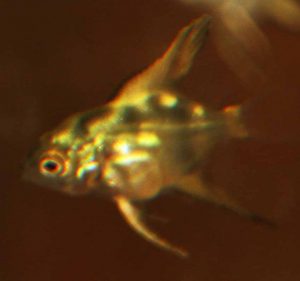Breeding Blue Angelfish
by Joe Graffagnino
At a Greater City Aquarium Society meeting last year, fellow member Jerry O’Farrell came up to me and asked, “Have you breed angelfish?” I said that I had, but it was over 25 years ago. He said. “Good, then it’s time you did them again,” and he thrust a bag of 8 beautiful quarter size blue angels in my hand. Before I could respond, he walked away. I looked at the plastic bag full of fish and marveled at how beautiful and majestic these little cichlids appeared. The blue on their heads stood out in dramatic contrast to their silver bodies.
I brought them home and placed them into a 20-gallon aquarium. The pH was 7.2, the temperature was 80 degrees Fahrenheit and the General Hardness (GH) was 4. The angels grew quickly, especially the dominant male who soon eclipsed his tank mates. The group fared well with bi-weekly water changes of 30 – 40 %, and feedings of flake food followed by live black worms or frozen blood worms. Occasionally they were fed live brine shrimp and/or frozen cyclopeeze. After 8 – 10 months, the group started to pair off. I moved the non-pairs of angelfish into a 10 gallon when in less than a month another couple had paired up. This new pair was moved into another 20-gallon tank.
The second pair of angelfish was sharing a habitat with Glo-Lite tetras, but that didn’t stop them from laying eggs on a tall piece of driftwood. Both parents kept the Glo-Lite tetras to the farthest end of the aquarium. They also took turns cleaning and fanning the eggs. I noticed from both breeding pairs of fish that the eggs that were fungused were left alone and not removed. I thought this was a poor cleaning job on the parents’ part.
I had a 25-watt heater that had the heating coil wrapped with airline tubing. I did this to prevent the fry from killing themselves on the heating coil. I placed the air tube with air-stone under the slate piece so the air bubbles would travel in front of the eggs. . I also added a dose of Acriflavin to reduce the infertile eggs from becoming fungused. As the eggs hatched, 5 days later, I moved the air-stone into an existing sponge filter several inches away from the hatching eggs and performed a water change to remove most of the Acriflavin. I replaced the water with parent tank water. The unfertilized eggs that did fungus remained on the slate until I removed them with a pipette. Several days later, the newborn fry was attaching themselves via their egg sack to everything in the tank – plant leaves, the slate piece, pieces of wood and rock. The fry can’t eat until they are free-swimming so I do not feed them because the food will only pollute the aquarium.
An interesting experiment was tried, accidentally, when I neglected to replace the slate board they lay their eggs on. There was a large wood piece that wasn’t solid, having holes throughout it. I saw them evaluating the wood piece, but I guess they weren’t satisfied with it. The only other object in the tank, except for the large sponge filter or the heater, was a small flat rock that I used to keep the slate board from slipping.

